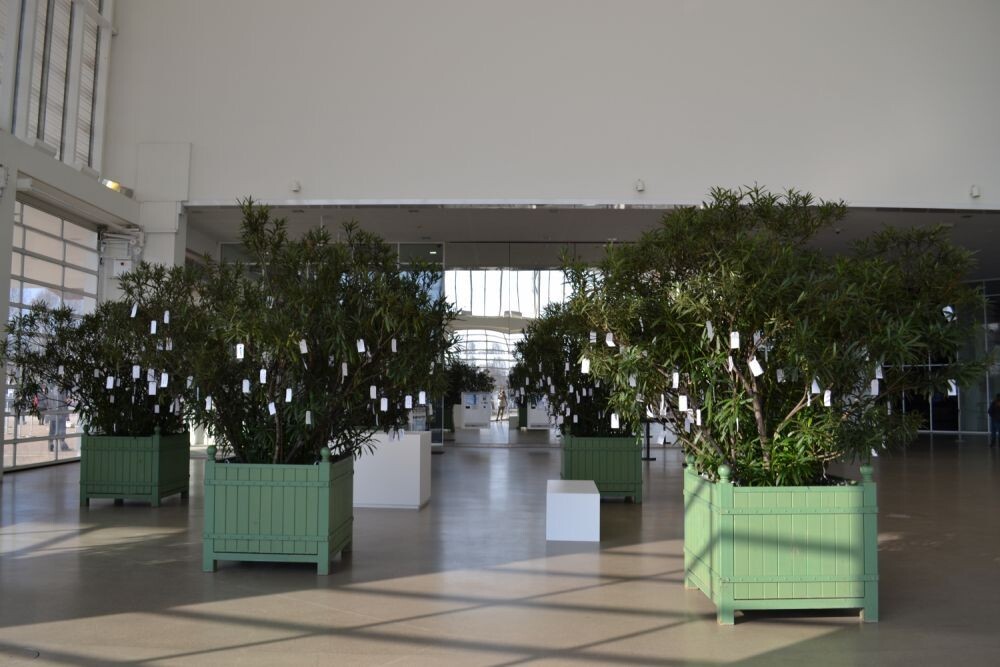
Datum
Ort
Forum
From February 2015, Yoko Ono’s Wish Trees will display their collective message of peace, hope and desire in the Forum of the Centre Pompidou-Metz.
Wish Tree is a poetic installation created by Yoko Ono and is the name for a series of works that she has produced since the 1990s, in which trees become components and props for her conceptual project. For Yoko Ono an artwork must create desire and arouse the spectator’s curiosity: “All my works are a form of wishing. Keep wishing while you participate”. She often talks about how, as a child in Japan, she wrote out wishes on small pieces of paper which she then tied around the branches of trees in temple courtyards. Yoko Ono thus encourages the public to become involved in the construction of the work, by sharing this desire to make wishes, by identifying desires and daring to write them down on small pieces of paper. Wish Tree is an invitation to meditate on the meaning of life and the importance of hope, desire and communication. Visitors are invited to leave a record with their words and impressions on small blank labels hung on the branches of the Wish Tree, and they become metaphorical actors in a collective dynamic movement.
The wishes collected in this way by Yoko Ono (of which there are now more than a million) are then kept at the site of IMAGINE PEACE TOWER, created by Yoko Ono in 2007 in memory of John Lennon, a beam of light and hope that illuminates the sky on the island of Viðey, near Reykjavik in Iceland.
Yoko Ono's commitment to peace has always been an element and theme throughout her work. Her early instruction works were about imagination and peaceful actions. In London 1966, at the DIAS (Destruction In Art Symposium) she performed Shadow Piece in a playground that had been bombed in WW II. She traced the shadows of participants, as reminders of the horrors of the Tokyo bombing that left only shadows of victims etched and burnt into the pavement. Acorn Event, 1968, was her first collaboration with John Lennon. She made an important statement for peace with her conceptual meeting of East and West. The event was part of the National Sculpture Exhibition in the gardens of Coventry Cathedral, England. Rejecting all notions of monumentality and spectacular, they created an embryonic sculpture by planting two acorns, one facing east and the other facing west, representing the union of East and West, their desire for peace between these two hemispheres and the need for ecological awareness.
After their marriage in 1969, Yoko Ono and John Lennon decided to turn their honeymoon into a public event dedicated to peace, called Bed-In, which took place at the height of the Vietnam War and resonated with the pacifist song named Give Peace A Chance. In the pacifist tradition of Martin Luther King and Gandhi, Yoko Ono’s work highlights the conceptual dimension of this performance, questioning the notions of identity and intimacy, space and time. On 15 December 1969, they launched an international publicity campaign for the promotion of peace in twelve cities around the world, with the message: “WAR IS OVER - if you want it - Happy Christmas from John and Yoko”, followed on 1 April 1973 by the invention of NUTOPIA, a nation living by the principles declared in the song “Imagine”, “a conceptual country with no land, no boundaries, no passports, only people. A country that belongs to all the world”.
Yoko Ono was born in 1933 in Tokyo. She is an artist and musician who has pushed the boundaries of poetic, conceptual and political expression. Her interest in art and music began at an early age. Her family emigrated to New York in 1952 where she studied poetry, music and composition at Sarah Lawrence College. She met Edgar Varèse, Morton Feldman and John Cage in the late 1950s and became part of the avant-garde music scene, along with her first husband, Toshi Ichiyanagi, a young Japanese composer. She was an active participant in the Fluxus movement, created in 1961 at the initiative of George Maciunas, which brought together a fluctuating and eclectic community of artists living in the USA, Germany and Japan.
Her work is celebrated in museums and galleries throughout the world and, in particular, by the retrospective of her work entitled Yes Yoko Ono held in Japan and North America in 2000. In 2009 she received the Lifetime Achievement Golden Lion at Venice Biennale. In May 2015, the Museum of Modern Art dedicates to her a major monography.
Avec le soutien de la Ville de Metz